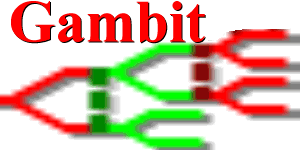 Gambit: Software Tools for Game Theory
Gambit: Software Tools for Game Theory
Sample games
- 2x2x2.nfg
- A three-player normal form game with two strategies per player,
due to McKelvey and McLennan. This game has nine Nash equilibria,
which is the maximal number of regular Nash equilibria possible
for a game of this size.
- 2x2x2-nau.nfg
- A three-player normal form game with two strategies per player,
due to Bob Nau. This game has three pure strategy equilibria, two
equilibria which are incompletely mixed, and a continuum of
completely mixed equilibria.
- bagwell.efg
- Stackelberg leader game with imperfectly observed commitment,
from Kyle Bagwell, Commitment and Observability in Games,
Games and Economic Behavior 8: 271-280, 1993.
- bayes2a.efg
- A twice-repeated Bayesian game, with two players, each having two
types and two actions. This game also illustrates the use of payoffs
at nonterminal nodes in Gambit, which can substantially simplify the
representation of multi-stage games such as this.
- cent3.efg
- A three-stage centipede game of the sort studied by McKelvey and
Palfrey, among others. This game features an exogenous probability
that one player is an “altruist” who always passes.
- condjury.efg
- A three-person Condorcet jury game, after the analysis of Feddersen
and Pesendorfer.
- loopback.nfg
- A game due to McKelvey which illustrates that the logit quantal
response equilibrium correspondence can have a “backward-bending”
segment on the principal branch.
- montyhal.efg
- The famous “Monty Hall” problem: if Monty offers to let you switch
doors, should you?
- nim.efg
- The classic game of Nim. This version starts with five stones.
- pbride.efg
- A signaling game from Joel Watson’s Strategy textbook, modeling
the confrontation in The Princess Bride between Humperdinck and
Roberts in the bedchamber.
- poker.efg
- A simple game of one-card poker used in Myerson (1991), Game Theory:
Analysis of Conflict.
- 4cards.efg
- A slightly more complex poker example, contributed by Alix Martin.
- spence.efg
- A version of Spence’s classic job-market signaling game. This version
comes from Joel Watson’s Strategy textbook.
